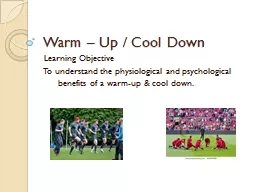

Learning Objective To understand the physiological and psychological benefits of a warmup amp cool down Effective warmup should include General warmup pulse raiser Stretching Specific warm up ID: 614028
Download Presentation The PPT/PDF document "Warm – Up / Cool Down" is the property of its rightful owner. Permission is granted to download and print the materials on this web site for personal, non-commercial use only, and to display it on your personal computer provided you do not modify the materials and that you retain all copyright notices contained in the materials. By downloading content from our website, you accept the terms of this agreement.
Slide1
Warm – Up / Cool Down
Learning ObjectiveTo understand the physiological and psychological benefits of a warm-up & cool down.Slide2
Effective warm-up should include:
General warm-up (pulse raiser)
StretchingSpecific warm up (practice of skills involved)Psychological preparation (focusing, anxiety control)Slide3
Benefits of warm-up:
Physiological Benefits:Better oxygen delivery to muscle tissuesImproved muscle blood flow
Increased speed of nerve conductionReduction in likelihood of muscular injuryIncreased heart rate.Psychological BenefitsControl anxiety.Focus mind.Practice skills involved.Slide4
Stretching Safely
Important points to consider when stretching during a warm-up:Warm-up / pulse raiser prior to stretching,
Make stretches sports specific,(begin) slowly,Stretches held for too long or not long enough could cause injury,Never hold a stretch which causes pain,No bouncing / ballistic movements,Balance / equalise stretches of the agonist and antagonist muscles.Slide5
Stretching
Must occur after the general warm-up.Must be specific to the activity.
Stretching improves flexibility, increases relaxation of muscles and improves muscles ability to withstand the forces involved in exercise.Stretching can be either static (no movement) or dynamic (with movement). There are 4 types of stretching you need to know about:Slide6
Types of Stretching
Active stretching
– holding a stretched position by contraction of your own agonist muscles.Increases active flexibility and strengthens agonist muscles. Difficult to hold for over 10s.Yoga based active stretchingPassive stretching – a stretch position being held by something other than the agonist muscles.Good for cooling down and reducing post-exercise muscle soreness.Slide7
Static stretching
– stretch to the limit and then
isometrically contract stretched muscles. Much more effective than the previous two for strength and flexibility.E.g. partner holds leg high while you try to push down or ‘push the wall’ calf stretch.PNF stretchingBallistic stretching – using movement to ‘bounce’ in and out of a stretched position. Can cause injury.Considered dangerous. Doesn’t allow muscles to adjust to stretched position. Can cause muscles to tighten due to ‘stretch reflex.’
Ballistic hamstring tearSlide8
Benefits of improved flexibility
Definition: the range of movement around a joint.Increased range of movement,
Decreased chance of injury,Ability to hold aesthetically pleasing gymnastic positions,Greater reach (e.g. tennis, basketball)Can apply more power / longer levers in athletic activities.Slide9
Benefits of a Cool-Down
Aids removal of waste products (lactic acid).Reduce potential for delayed onset of muscle soreness (DOMS).Reduce chances of dizziness or fainting caused by pooling of blood at extremities.
Reduce level of adrenaline in blood.Allow HR to gradually return to normal rate. Should include 5-10mins walk/jog and 5-10mins static stretching.